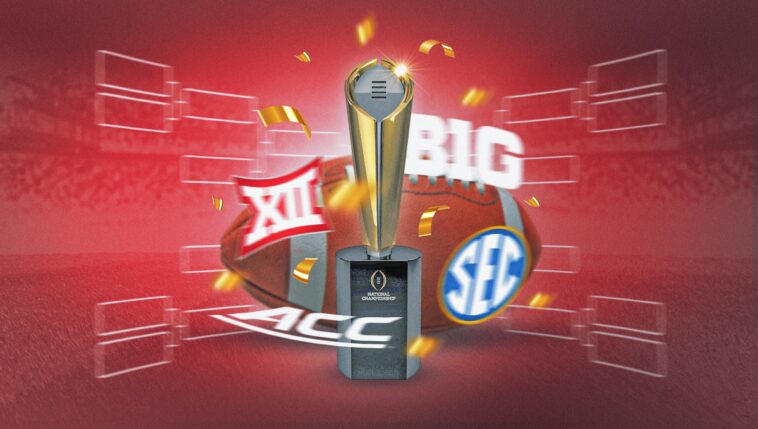In a fourth-floor conference room inside the Gaylord Hotel, just north of the Dallas-Fort Worth airport, 13 members of the College Football Playoff selection committee began meetings Monday and will meet all day Tuesday before producing, for the first time this season, their Top 25 rankings.
None of that is really new. This is the 11th year of the same process.
What is new: They are creating rankings that will apply, at the end of the season, not to a four-team playoff but a 12-team playoff. Their rankings, however, are not expected to reflect the playoff change. They will rank the teams as they normally have done — the best 25 teams in that order regardless of conference affiliation, etc.
For all of us on the outside looking in, we will apply those rankings to the new 12-team playoff format. Here are the rules of the new format:
– Rule 1: The five highest-ranked conference champions automatically qualify for the field.
– Rule 2: The four highest-ranked conference champions are seeded Nos. 1-4 and get a first-round bye (to re-emphasize this: teams that did not win their conference championship cannot get a bye and cannot be seeded better than No. 5).
– Rule 3: After the four highest-ranked conference champions are seeded, the next seven highest-ranked teams advance into the field through at-large spots and are seeded based on the order of their ranking. The fifth highest-ranked conference champion is also seeded based on its ranking order.
– Other particulars:
(1) independents, like Notre Dame, are not eligible to receive a top-four seed or a bye.
(2) first-round games between Nos. 5-12 seeds, Nos. 6-11, Nos. 7-10 and Nos. 8-9 are played Dec. 20-21 at the site of the better seed.
(3) quarterfinals, this year, are held at the Fiesta Bowl (assigned to the Big 12 champion), Peach Bowl (ACC champ), Rose Bowl (Big Ten champ) and Sugar Bowl (SEC champ).
Got all that? It can get confusing, as the committee’s rankings will likely not correlate with the playoff bracket seeding. For instance, if this year’s Big 12 champion is ranked No. 7 and is the fourth highest-ranked conference champion, that team is seeded No. 4. Here’s another example: If the SEC championship game loser is ranked No. 3 and is the highest-ranked non-champion, that team is seeded No. 5.
Now, let’s get to a few issues we’ll be watching in the CFP rankings as it relates to the 12-team field. We can learn a lot about the committee’s thinking about three areas:
(1) The power conference pecking order.
(2) Notre Dame, bubble teams jockeying for at-large spots.
(3) The race for the fifth conference championship access spot (G5).
The power conference pecking order
The polls are quite clear about which team is No. 1.
Oregon garnered all 62 available first-place votes in the latest AP poll. But who’s next? And how far down the rankings are the Big 12 and ACC’s best teams?
These are key questions as the four power leagues jockey for the top four seeds, and it gives us a window into what the committee thinks of each conference’s overall strength (that’s important for later when it is deciding at-large berths among teams with similar or the same records from different conferences).
In the AP poll, the ACC’s highest-ranked team is Miami at No. 4 and the Big 12’s is BYU at No. 9. The number of spots separating BYU and Boise State — likely the highest-ranked Group of Five team — is a big, big deal. It gives us a window into the probability of Boise actually surpassing a power league champion to get the No. 4 seed. It seems improbable without an upset in a championship game (like, for instance, a two-loss Colorado beating BYU in the Big 12 title bout). But it’s not out of the question.
At the top of the rankings, the power conference pecking order may also give us an idea of what teams could take a second loss and still get an at-large berth. In the AP poll, the second-best teams in the SEC and Big Ten are Texas (No. 5) and Ohio State (No. 3). The third-best SEC team is Tennessee (No. 7) and for the Big Ten is Penn State (No. 6). Will the selection committee agree on the pecking order for those four potential non-champions? It’s important.
And where are the ACC and Big 12’s second-best teams? Is there a chance either league is a two-bid conference? The Big 12 is in the most dangerous position of having its second-best team left out. Iowa State is ranked No. 17 in the AP poll. The second-best ACC team is SMU. The AP poll has the Mustangs at No. 13 (two spots out of an at-large berth, which we discuss below).
Notre Dame and bubble teams
Notre Dame’s ranking will be one of the more fascinating items on Tuesday night. The Irish are, for one, polarizing to begin with as college football’s last standing blue-blood independent. But they also have what is likely the worst loss of any playoff contender: at home to a Northern Illinois team that is now 4-4 on the season.
As a reminder, the Irish’s only route to the playoff is one of the seven at-large spots. They cannot get a bye and one of the top four seeds. If you’re wondering how that came to be, look to former Notre Dame AD Jack Swarbrick, who agreed to the concept during deliberations with CFP commissioners in 2021 when the playoff format was introduced. In retrospect, it’s quite savvy. The Irish don’t have to play in a 13th game and can still punch their ticket as long as they finish high enough in the rankings.
In the AP poll, Notre Dame is ranked No. 10, squarely on the bubble for an at-large bid. If the 12-team format were applied to the AP poll, the Irish would travel as the No. 10 seed to play at No. 7 seed Penn State.
Who else is on the bubble? Two-loss Alabama, ranked No. 11 in the AP poll, would get the last at-large spot if the 12-team bracket were applied. SMU is a spot behind that. Three two-loss SEC teams follow in LSU, Texas A&M and Ole Miss, and one-loss Iowa State is next. The Tide and Tigers tangle this weekend in Baton Rouge — the first real elimination game between two playoff contenders this year. The loser is almost certainly out.
But will the committee agree with the AP’s order? How do you differentiate between those four two-loss teams? Well, start with the fact that A&M beat LSU and LSU beat Ole Miss. Thus, the pecking order behind Alabama seems obvious: Texas A&M, LSU, Ole Miss. The Aggies should root for the Tigers in the game against Alabama. Ole Miss’ home loss to a 3-6 Kentucky hurts, and Iowa State’s strength of schedule rank (36th in Sagarin) does it no favors. But don’t forget this: The Cyclones won at an Iowa team that is 4-2 in the Big Ten.
There are a few other teams with an outside shot to get on the bubble, including two-loss Clemson, perhaps, and one-loss Pitt (they meet next week, by the way). But the most intriguing of the possible bubble teams is none other than Washington State, one of the remnants of the old Pac-12.
The Cougars are 7-1 with wins over a 5-4 Big Ten team (Washington) and a 6-3 Big 12 team (Texas Tech), and their only loss is at the 12th-ranked team in the country (Boise). Washington State, ranked No. 20 in the AP, is not eligible to receive a conference championship qualifier and must finish highest enough in the rankings to get an at-large spot. Do they have any shot? If the committee ranks them inside, say, the top 16 on Tuesday, they might just have a chance, despite a quasi-Group of Five schedule.
The race of the G5s
Boise State is almost certainly to be the committee’s highest-ranked Group of Five team, setting up the Broncos to advance to the playoff if they win their remaining regular season games and the Mountain West championship.
On the back of Heisman Trophy-contending running back Ashton Jeanty, that shouldn’t be too much of an issue. Just one of their final four opponents have a winning record. The Mountain West title game will likely come against UNLV or Colorado State. Boise State already beat the first of those and the Rams have a loss to Oregon State.
But what if the Broncos trip up along the way? The American Athletic Conference champion awaits to steal the bid — maybe. Army, ranked 18th in the AP, is undefeated and though the Black Knights have the worst-ranked schedule of all the G5 playoff contenders, they have a massive opportunity on Nov. 23: a game against Notre Dame in Yankee Stadium.
A win there could, suddenly, have the selection committee toying with the idea of leaping Army over Boise State in its rankings. Boise State’s best win is, in reality, a loss: a three-point defeat at top-ranked Oregon. The Broncos also won at UNLV, which beat middling Big 12 teams Kansas and Houston.
When the committee’s rankings are revealed, pay attention to how close — or far apart — Boise State and Army are. And where is Tulane? The Green Wave have two losses, but both were relatively close and against Kansas State and Oklahoma. Another CFP contender: Louisiana. The Cajuns are a surprising 7-1 and lead the Sun Belt. They won at Wake Forest and lost a tight one to Tulane.


